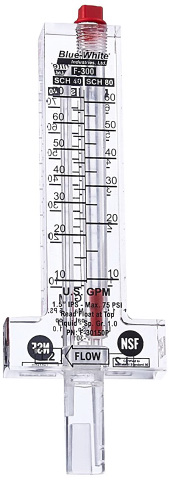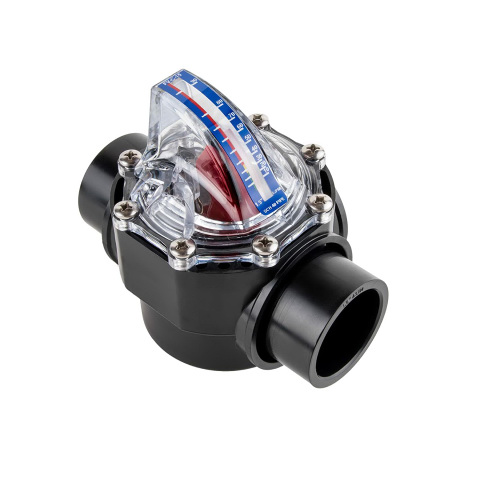Maintaining your pool perfectly requires the correct flow rate and water turnover. Get this wrong and your pool will be prone to algae and cloudy water.
Enter the flow meter or flow sensor. You probably know that a flow meter will measure the number of gallons per minute your pump moves. But do you need a flow meter for your pool? Is it necessary?
A pool flow meter is not required by law for a residential pool, however, it is a highly recommended piece of pool equipment to ensure the proper flow rate of a swimming pool. Although pool flow rate can be manually calculated, using a flow meter will yield a far more accurate measurement.
Let’s take a look at why you’d bother using a flow meter. Hint, it’s absolutely for some pool systems.
Article Contents
What is a Pool Flow Meter?
A pool flow meter or flow sensor measures the amount of water moving through a given point over a set period of time. In the US, this is measured in Gallons Per Minute or GPM. In other parts of the world, it’s measured in Litres Per Minute or LPM.
Although the pool’s water flow rate can be calculated manually, a pool flow meter is the most accurate way to measure how much water a pool pump is moving. Having an accurate measurement of the pump’s flow rate will ensure that the optimum water filtering (turnover) is carried out.
We have a full article on choosing the correct size pump for your pool which goes into more depth on turnover rates and the calculations:
How to Choose the Ideal Swimming Pool Pump
How a Pool Flow Meter Works
The device is installed in one of the pipes, usually directly before or directly after the pool filter. There are different types of flow meters but in general, they measure the speed of the water flowing past the meter. From this, the meter calculates the water volume that is flowing in one minute.
Best Flowmeters/Flow Sensors for Pools
Here’s our picks for the best flow meters and flow sensors for your pool.
Flow Vis H2flow (suits 1.5″ pipes)
Click here to check price >>
Flow Vis H2flow (suits 2″ & 2.5″ pipes)
Click here to check price >>
Blue-White Flowmeter (suits 1.5″ pvc pipes)
Click here to check price >>
Blue-White Flowmeter (suits 2.0″ pvc pipes)
Click here to check price >>
Blue-White Flowmeter (suits 2.5″ pvc pipes)
Click here to check price >>

Should You Use a Pool Flow meter?
To have a clean pool free from cloudy water and algae, it’s vital that the water is filtered enough. The optimum amount of filtering is for all the pool’s water to run through the pool filter 2-3 times in a 24 hour period.
The time it takes the filter to filter all the pool’s water is called the turnover rate.
A pool flow meter will help you to know this.
A pool flow meter will also help you to diagnose problems with the pool’s flow as it makes it very easy to check the flow rate and determine if the pump’s flow rate is normal.
How do you know if all the pool’s water has been filtered?
You need to know two things to work this out:
- Pool volume
- Pump Flow Rate or Pump GPM
When you have these two pieces of information, you can calculate the turnover rate or, the time it takes for the pump to filter all the pool’s water once. Usually, you need this to happen in 6-8 hours. That way, running your pump for 10-12 hours will mean the water will be filtered up to 2 times.
Water Turnover Time = Pool Volume (Gallons) / Pump Flow Rate (GPM)
Calculating the Pool’s Volume
The easiest way to work this out is to use a pool volume calculator, which you can find here.
Calculating Your Pump Flow Rate or GPM
Working out the pool’s water volume isn’t so hard, but the pump’s flow rate is more difficult to measure accurately.
This is where things get a bit tricky. It’s not as easy as looking at the pump manufacturer’s specifications for flow rate. Yes, the manufacturer will list the pump’s flow rate, but pumps perform differently for each individual pool system. No system is the same.
In the real world, there are multiple factors that affect the flow rate of a pool pump:
- Length of the pipes
- Diameter of the pipes
- Size of the filter
- Number of water features (spa, jets, fountain etc.)
- Distance of pump from pool
- Is the pump lower or higher than the water level
- Other pool equipment such as pool heaters
All of these factors impact the pump’s flow rate and decrease it. These factors are called Total Dynamic Head (TDH). Calculating TDH can be done but it’s not easy for the average pool owner or even some pool technicians. Usually, it’s just estimated.
Given all the variables, it’s far easier to install a flow meter. Then you will know with certainty what your actual flow rate is. And when you know that, you can accurately calculate the flow rate you are getting and know if it’s correct.
As a side note, variable speed pool pumps come with an inbuilt flow meter, which is necessary for setting them up to run most efficiently.
Related Reading: Pool Pump Current (Amps) – 0.5 to 2.5 HP Motors
Different Types of Flow Meters
Flow meters come as a separate stand-alone device that is installed in one of the pool pipes. They also come integrated into other swimming pool equipment such as solar pool heating controllers and automatic chemical feeders. If you have one of these pieces of equipment, you may already have the ability to read the water flow without having to install a stand-alone meter.
There are several brands that manufacture stand-alone flow meters and flow sensors for swimming pools. These include Blue-White, H2 Flow Controls and Rola-Chem.
There are also two main types of flow meters:
Analogue Flow Meter
These flow meters have been around a long time. They are mechanically driven, which means they don’t take batteries and are “powered” by the flow of the water alone.
They are simple devices and indicate the water flow via a floating pointer, sort of like a thermometer. Since they are mechanical only, they tend to last a long time as there are no electronic parts to malfunction.
Usually the measurements are in Gallons per Minute, Litres per Minute or both.
Digital / Electronic Flow Meter
Digital pool meters are the newer style of flow meters. They work similarly to an analog meter except that the readout of the measure is via a digital display screen. Since the display is digital, it can be a little easier to read and a little easier to get an accurate reading.
Either kind, digital or analog, will work well for your pool. The extra accuracy of digital isn’t really necessary for pool owners.
Size of Fittings
It’s important to know that when choosing a flow meter for you must know your pool pipe diameter. This is because flow meters are made to fit different size pool pipes. Common sizes are 1.25″, 1.5″, 2″, 2.5″ pipes.
Profile of the Meter
Some flowmeters sit almost flush with the pipe, whilst others protrude a lot further. The meter you choose will depend on the amount of space you have. Keep in mind, the meters that stick up can be bumped and damaged if they are located in a place where you need to regularly get to.
How Much Do Pool Flow Meters Cost?
As with anything, the cost will vary depending on the brand and size of pipes you have. You can purchase a good quality flow meter for around $70. They range in price up to about $200.
How Do You Install a Pool Flow Meter?
In most cases, you’ll need to cut your existing pool lines to install the meter. As mentioned earlier, it’s important to choose a flow meter with outlets that match the diameter of your pool’s pipes.
Pool flow Meter Placement
The placement of the flow meter will affect the accuracy of the measurement. For the most accurate reading, choose a position in the pipe with a long (at least 13″), straight run (or as long as possible). It’s best not to position the meter near a corner if you can help it.
The meter will be spliced into the existing line. Here’s a video showing you exactly how to do this.
Final Thoughts
Having a pool flow meter certainly has some major advantages, and most pool technicians will tell you it’s vital to know your flow rate. Knowing your flow rate accurately will let you know if you’re filtering your pool’s water enough. It will also help you determine if your system is running properly or not.
Related Reading: Can You Downsize a Pool Pump?


